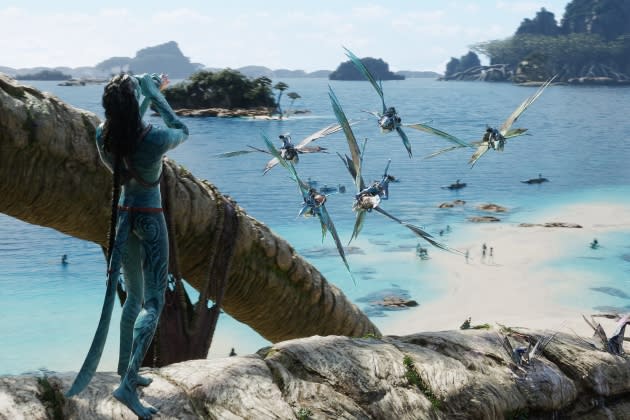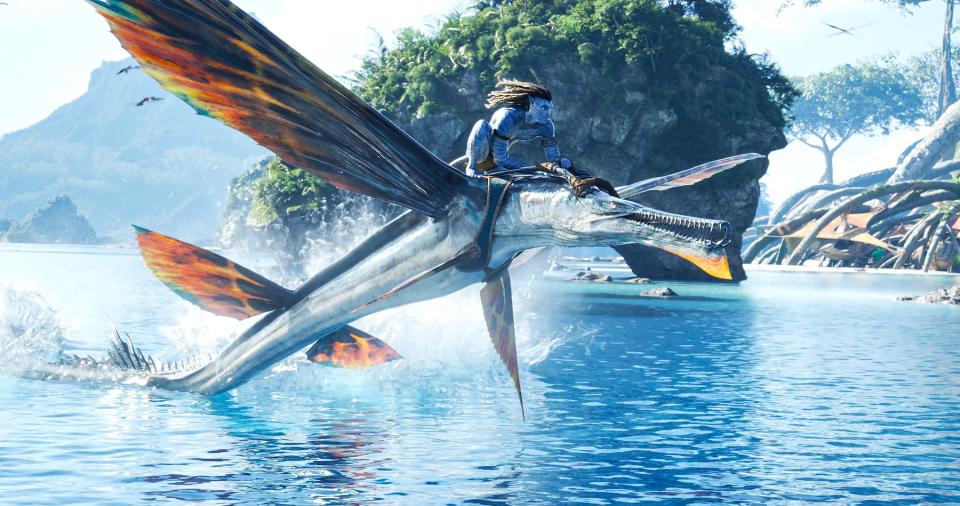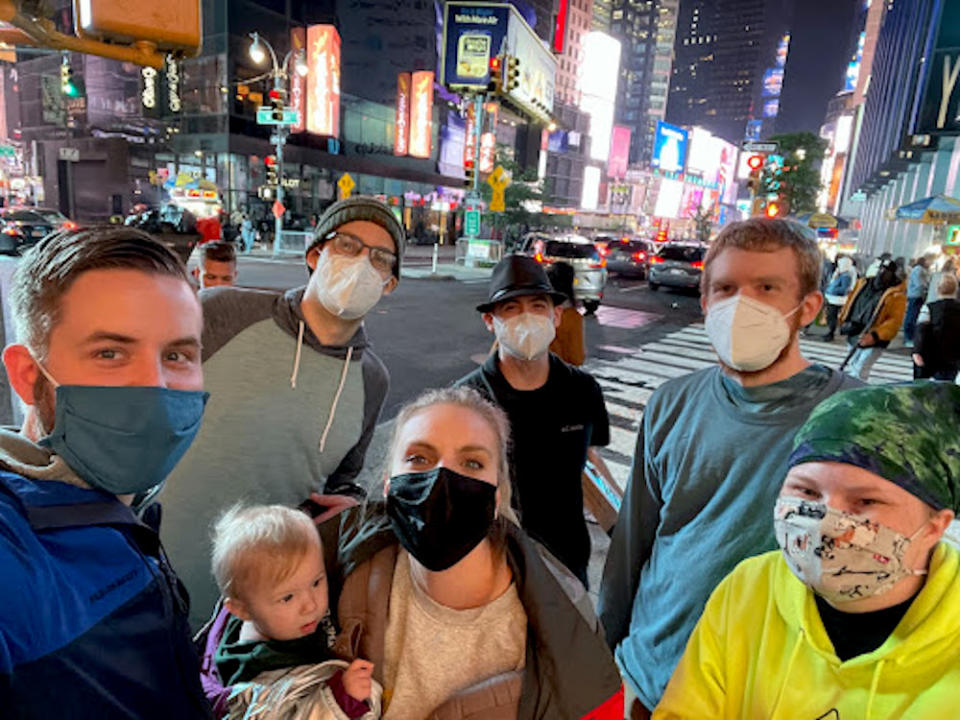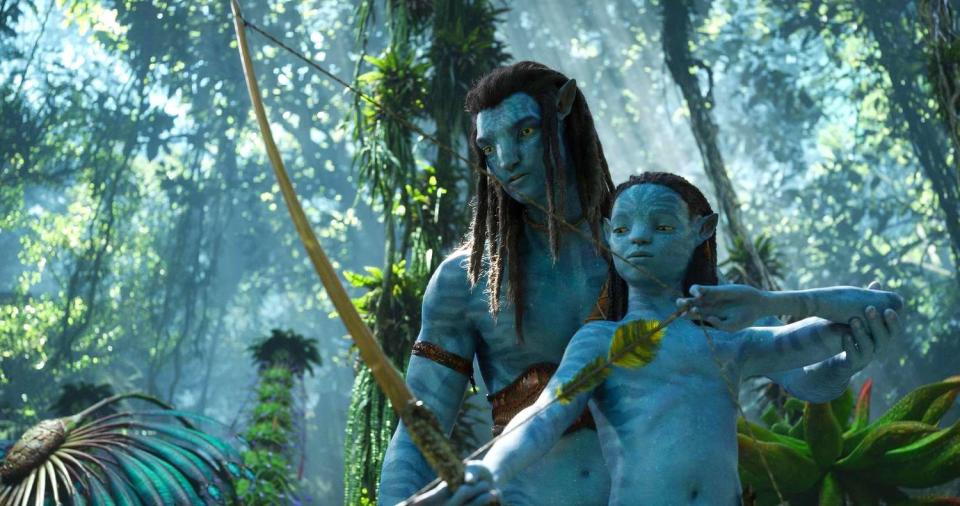‘Avatar: The Way of Water’: Meet the Real-Life Na’vi Community
- Oops!Something went wrong.Please try again later.

After 13 years, the blockbuster sequel Avatar: The Way of Water has finally been unleashed into the world, earning $441.6 million worldwide in its opening weekend. It is the first of four planned sequels from filmmaker James Cameron and came at a cost of $350 million, making it the most expensive motion picture ever.
The first Avatar film is set in the year 2154. With Earth dying, the RDA corporation has been mining the valuable mineral unobtanium on Pandora, a far-off moon filled with lush forests inhabited by the Na’vi, a race of tall blue humanoids who are one with nature. Jake Sully (played by Sam Worthington), a paraplegic ex-Marine, is recruited by the RDA corporation to participate in the Avatar Program—transforming humans into Na’vi to explore Pandora. Instead of aiding Col. Quaritch (Stephen Lang) in the humans’ invasion, however, he falls in love with a female Na’vi, Neytiri (Zoe Saldana), and eventually leads the Na’vi resistance. In Avatar: The Way of Water, Sully and Neytiri must protect their family, and a Na’vi island-dwelling community, from Quaritch, RDA, and a pack of rapacious whalers.
More from Rolling Stone
Avatar became a full-blown cultural phenomenon upon its 2009 release, grossing nearly $3 billion at the global box office and earning itself a very dedicated following.
“It was the first time that I can genuinely remember feeling like a film had transported me in a way that kind of stepped into an entirely new reality,” said Seth Wright.
Wright was a high school freshman when he first saw Avatar on Christmas Eve 2009. Now, he is 28 years old and the co-founder of Kelutral (meaning “Hometree’ in Na’vi), an organization that describes itself as “a living, growing home” for the Avatar community. It was created in 2020 with a mission to spread the Na’vi language.
“After seeing [Avatar] three or four times, I started looking for ways to continue to engage with the film outside of the theaters,” said Wright. “And one of the things that interested me was the functional language that they had used for the Na’vi people in the film.”

Dr. Paul Frommer, a professor with a PhD in linguistics from the University of Southern California, created the Na’vi language in 2005 for the first Avatar. He based it in part on Polynesian languages, and a dozen or so words crafted by Cameron.
“[Cameron] wanted a complete language, with a totally consistent sound system, morphology, syntax,” Frommer told NPR. “He wanted it to sound good — he wanted it to be pleasant, he wanted it to be appealing to the audience.”
Creating a new language from scratch is no picnic. Frommer first established a set of approximately 500 Na’vi words to meet the needs of light conversations in Avatar. The Na’vi language gradually developed and reached 1,000 words at the time of the first film’s release. People, naturally, took notice.
In early 2010, Wright joined Learn Na’vi, an organization working to reverse engineer the Na’vi language. From there, Wright and his team have worked with Frommer to continue to develop the Na’vi lexicon.
“The language wasn’t really published yet at large. At that point, people were using movie lines that they heard or there was like a little dictionary out at the time, but it had like only 450 or so words,” said Corey Scheideman, also known on Discord as Tirea Aean, meaning “Blue Spirit” in Na’vi.
Shortly after watching Avatar, Scheideman googled the Na’vi language to find out if it was real. As more information on it became available, online Na’vi enthusiasts began categorizing the information into Wikipedia pages, and shared online documents. The language now has a variety of grammar documents, a major dictionary, and other learning workbooks. Scheideman has been learning and teaching the Na’vi language for more than a decade as part of Learn Na’vi.
As a main hub for Avatar’s online community, Learn Na’vi provides every member with a wealth of Na’vi resources to immerse themselves in the language. Anyone interested can access the Na’vi dictionary, which is published on the website in 10 different languages (including Na’vi, of course). There are other learning resources such as vocabulary, grammar, phonetics, phrases and numbers. A link to their Discord chat, along with a feed of all the latest Avatar and Na’vi language news, is also available on their website. But the ultimate authority for the Na’vi Language is on professor Frommer’s blog Na’viteri.org. There, students of the language can make suggestions for the creation of new words, and Frommer frequently announces new words and grammatical changes on the site.
With more than a decade of involvement in the Learn Na’vi community, Wright has made friends and forged connections with like-minded people, which made him realize that a space is needed for those interested in learning the Na’vi language.
“The people who actually like to devote themselves to learning an entire constructed language, as you can imagine, are a lot slimmer than the people who are just broadly interested in the language itself,” said Wright.
Wright co-founded Kelutral so that Na’vi scholars all over the world can expand the reach and help modernize this unique language.
“If you cannot do it with the tools provided, then you have got to create your own,” said Wright, “and that’s how Kelutral came to existence.”
Kelutral is a hub for over 3,000 members to study and communicate with each other via Discord, and where over 30 kinds of Na’vi language resources are available, from an entry-level Na’vi alphabet to in-depth grammar courses and other materials.
Like its namesake the Hometree, sacred sites on Pandora that serve as the home for entire Na’vi clans (and sits atop a large supply of unobtanium), Kelutral is a “virbrant and inclusive” network with branches reaching to different parts of the world. User data shared by Wright indicates that Germans are the largest demographic of the Kelutral language community.
“There are people around the world who don’t speak English, but have learned Na’vi,” said Wright, “I have a common language with them and can communicate with them even though I may not speak their native tongue.”
In addition to serving as a space where people can communicate with each other through the Na’vi language, Kelutral also helps cure members from “Post-Avatar Depression.” People suffering from this undiagnosed syndrome view Pandora as a land so idyllic and awe-inspiring that the real world simply cannot compare.
“I felt like that was an amazing dream, but now I had to wake up. I had to return to the doldrum of reality, trying to figure out what I was going to do with my adult life,” Max Perrin, a 24-year-old digital artist in Texas, told Variety of his experience seeing Avatar. “I had been struggling with depression and I didn’t know what it was. I didn’t have a name for it. I was not allowed to seek out mental medical treatments, psychotherapy or anything like that. My family had religious views that were diametrically opposed to a lot of science and medicine.”

Perrin and Wright, along with a few other Kelutral members, met up with documentary filmmaker John Wilson to film an episode for his HBO documentary series How To with John Wilson. In the episode, titled “How To Remember Your Dreams,” Wilson joins a Kelutral meetup in New York City. Several members explain that the community has shown them support in not only learning the language and the culture, but also to form bonds with each other that impact their everyday lives.
Wright and others involved in Kelutral believe that since everyone involved is a dreamer, they have the capacity to help provide comfort and care to one another.
“I know from the bottom of my heart that our community is open, welcoming, and inclusive,” he said.
The Na’vi community is growing steadily as more and more people join Learn Na’vi and Kelutral. What started as a set of about 500 words has grown to around 2,600. Its popularity has also made the Na’vi language one of a handful of languages selected in a research study at MIT on language networks in human brains conducted by McGovern Institute investigator Evelina Fedorenko and PhD candidate Saima Malik-Moraleda. The others are Esperanto, Klingon (Star Trek), and Dothraki and High Valyrian from Game of Thrones.
According to Malik-Moraleda, language tends to be left-lateralized and the language regions in the left hemisphere of the brain are highly selective.
“These regions respond only to language, and not to anything else,” said Malik-Moraleda. “It doesn’t do math, it doesn’t do music, it doesn’t do any other tasks.”
This pattern of language processing was found after about 45 different languages were tested by Malik-Moraleda and her team. But all of the tested languages are natural languages, so they started to look at constructed languages as well, such as Na’vi.

In early November, some Na’vi speakers from Learn Na’vi and Kelutral, including Scheideman, participated in MIT’s “Brains on Conlangs” study, where their brains were scanned while listening to sentences spoken in the Na’vi language. The study is still on the hunt for more participants who are proficient in Na’vi.
To celebrate the long-awaited release of Avatar: The Way of Water, Kelutral will be hosting their 3rd annual virtual event OmatiCon 3 in January. An in-person OmatiCon event is set to take place next August at the Whitewater Center in Charlotte, North Carolina, where Avatar fans can gather along with other fans around the world for games, trivia, and panel discussions with special guests, including the head of publishing for Lightstorm, Cameron’s production company, and one of the creature designers from the movie sequel production team.
Compared to previous online events in which members get together for a day to chat and re-watch Avatar, this year’s Omaticon will expand to two days to provide fans with more time to communicate with each other about the Avatar world, including the sequel they’ve spent more than a decade waiting for.
“It is a piece of our culture that we’re very intent on protecting as we go into the sequels and onward,” said Wright. “But that is exactly who we are. We are that community. We are a supportive network of people.”
Best of Rolling Stone

